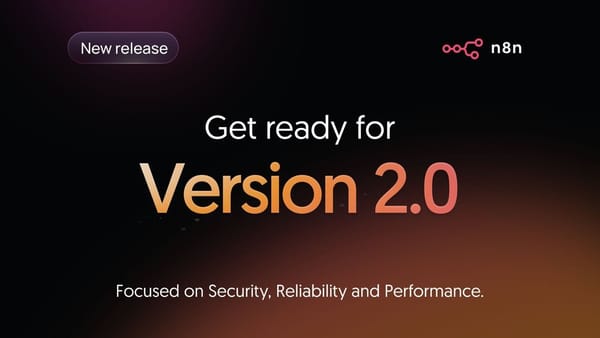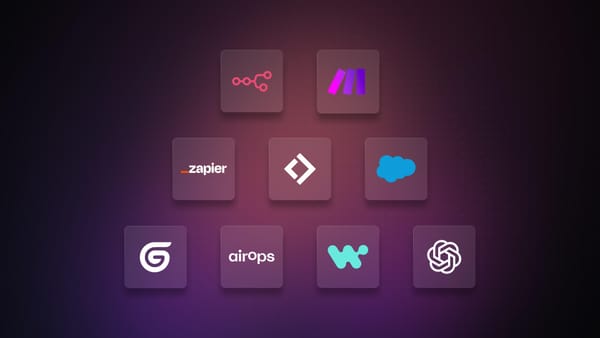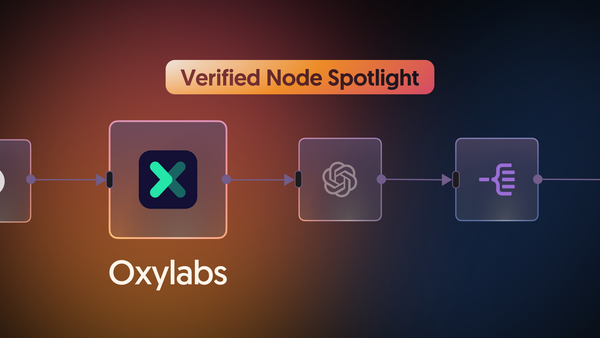ETL (Extract, Transform, Load) tools – the backbone of efficient data pipeline management. As we navigate through 2024, the demand for ETL solutions that are flexible, scalable, and cost-effective continues to rise.
That's where open-source ETL tools come in!
In this article, we'll explore eight popular open-source ETL tools, their key features, as well as their pros and cons:
- Apache Airflow
- Apache Kafka
- dbt
- Airbyte
- Meltano
- Singer
- Mage
In the context of ETL, we'll also take a look at n8n which offers a highly flexible, source-available platform that allows users to automate data extraction, transformation, and loading processes with customizable workflows, making it a powerful tool for streamlined data pipeline management.
Stay ahead in the data game with our comprehensive guide!
Is Python good for ETL?
Before discussing the list of 7 open-source ETL tools, let’s examine what Python, a popular choice among data engineers and analysts, can do.
Python is good for ETL, and in specific:
- Python has a vast collection of libraries specifically designed for data processing, such as Pandas, NumPy, and SciPy. These libraries provide powerful tools for handling large datasets and performing complex transformations.
- Python also allows you to easily automate and schedule your ETL jobs using CronJobs. This is especially useful when dealing with recurring tasks or real-time data updates.
- Python can seamlessly integrate with popular databases like PostgreSQL, allowing you to directly load transformed data.
However, Python may not be the most efficient choice for large-scale ETL projects where scalability is crucial:
- Python is an interpreted language, which means it may not be as fast as compiled languages like Java or C++. This can lead to longer processing times for large datasets.
- As with any programming language, maintaining and debugging code can be time-consuming and require technical expertise. This can add to the overall cost of using Python for ETL processes.
- Unlike some other ETL tools, Python does not have a built-in graphical user interface (GUI) for designing workflows. This means that you will need to rely on coding and scripting to create your ETL pipelines. While this offers more flexibility and control, it can also be daunting.
What is the best open-source ETL tool?
That's where open-source ETL tools come in handy. They can help solve many of these issues.
Let's have a look at the best ones below!
Apache Airflow

Apache Airflow is an open-source platform used for orchestrating, scheduling, and monitoring workflows.
Airflow's core strengths lie in its powerful scheduling capabilities, parallel data processing, and extensibility through custom operators and plugins.
It excels at managing, organizing, and scheduling data pipelines. It employs Directed Acyclic Graphs (DAGs) to define the sequence and dependencies of tasks that need to be executed, making it easier to visualize and manage the workflow.
Key Features
- Dynamic scheduling and dependency management with DAGs;
- Web-based UI for workflow management and monitoring;
- Rich command line utilities.
Pros
- Scalable, parallel data processing capabilities;
- Good tracking of data lineage;
- It has a strong community and supports customizations.
Cons
- Steep learning curve compared to other tools, especially for beginners;
- Installation and setup can be complex;
- Requires basic knowledge of Python to create custom operators/plugins.
Our Take
Apache Airflow is a widely known orchestration tool, so if you require good community support, this is for you. Also, as a Python developer, you’ll be glad to have this for your ETL jobs since it all integrates well together. However, this tool requires more technical knowledge like learning Jinja templating and using operators.
Apache Kafka

Apache Kafka is a popular open-source stream-processing platform commonly used for building real-time data pipelines.
It also offers easy integration with other tools through connectors and APIs. Streaming applications can be built to process the data in real time using various libraries like Spark or Flink.
Key Features
- High throughput, low latency, and fault tolerance;
- Scalability in handling large volumes of streaming data.
Pros
- Efficiently processes streaming data in real-time;
- Supports multiple programming languages for writing stream-processing applications.
Cons
- May have some limitations when handling batch processing workflows compared to other ETL tools;
- Too much setup for simple ETL pipelines;
- Lack of ETL operation monitoring tools.
Our Take
Kafka is an excellent choice for big data applications. Its best use is sending messages for notifications within apps. For most cases within small to medium-sized companies, Apache Kafka may not be the right solution.
Also, while Kafka itself doesn't provide out-of-the-box ETL capabilities like some other tools such as Apache NiFi or Apache Spark, it can be a critical component within an ETL pipeline. Kafka can be used for data ingestion (Extract), processing of data streams (Transform), and routing data to various destinations (Load). However, additional tools or custom development may be needed to perform the transformation and loading steps effectively.
dbt

dbt (data build tool) is the analytics engineer's toolkit for transforming data within the data warehouse through SQL. Its simplicity and focus on end-to-end data flow automation make it an increasingly popular choice among data professionals.
It's open-source implementation, dbt core, is a tool that lets you define and build data transformations according to your business logic.
dbt’s plugin architecture allows for extensibility with numerous data platforms, including both on-premises databases and cloud solutions like Snowflake, Google BigQuery, and Amazon Redshift.
Key Features
- Automated data pipeline management, documentation, and testing;
- SQL coding structure with Jinja templating;
- CI/CD integration for testing and deployment automation.
Pros
- Encourages best practices in analytics code development;
- Less technical compared to other tools, leveraging SQL skills.
Cons
- Limited support for non-SQL data sources;
- Can be difficult to troubleshoot errors due to its modular structure;
- Limited by functionalities of SQL.
Our Take
A common tool in analytics engineering, dbt is highly focused on SQL usage across a pipeline. As it is just a data transformation tool, it still requires a combination of tools like Airflow for orchestration, for example.
Airbyte

Airbyte is an open-source ELT project that allows data to be extracted from various sources and loaded into a data warehouse or destination of choice.
Key Features
- Easy to set up and deploy with a user-friendly UI;
- Has a Connector Development Kit (CDK) for building new connectors;
- Offers a wide range of integrations through connectors.
Pros
- Has a No Code Connector Builder for low code development;
- Offers both local deployment (via Docker) and cloud deployment options (via VM or Kubernetes).
Cons
- Limited features compared to other ETL tools, such as scheduling or monitoring capabilities;
- Not suitable for complex data transformation logic;
- Some connectors may have limitations in terms of data loading speed.
Our Take
The CDK for creating custom connections on Airbyte is a good feature to have if you need to build out a specific ETL pipeline. Creating the CDK requires coding knowledge, so it can help you get things up and running faster. Airbyte is also great for managing all your pipelines in one place instead of having to run classes separately in Airflow.
However, one issue that may come up is that a pipeline with a mix of Java source connectors and Python connectors can be really tough to debug.
Meltano

Meltano is an open-source data pipeline framework that simplifies ETL and ELT processes for data engineers.
It is built on top of existing tools such as Singer, allowing for easy integration with various data sources and warehouses.
Key Features
- Supports both ETL and ELT processes;
- Integrates multiple open-source tools (e.g. Singer, dbt, and Airflow) for a full data pipeline solution;
- Uses a plugin system that consists of extractors, loaders, and utilities;
- Offers a CLI and version control for pipeline management and monitoring.
Pros
- Simplifies the ETL process by integrating multiple open-source tools in one framework;
- Supports both batch and real-time data processing;
- Has an SDK for building custom connectors.
Cons
- Limited support and documentation compared to other ETL tools;
- It may require some knowledge of the underlying open-source tools (Singer) used in the framework.
Our Take
Meltano is great for configuration using just the CLI, and that helps speed up the process of building an ETL pipeline. However, potential users should keep in mind that there may be a learning curve involved with understanding and utilizing all of Meltano's features.
Singer

Singer is an open-source, command-line tool that facilitates data extraction and loading processes. It’s designed to simplify the integration of various data sources, making it easier for developers and analysts to move data to their desired destinations.
Employing a specification for writing scripts, known respectively as "Taps" (for data extraction from sources) and "Targets" (for loading data into destinations), Singer enables a modular approach to ETL processes.
This allows users to mix and match Taps and Targets to create custom data pipelines catering to their specific needs.
Key Features
- Uses a modular approach that allows for customization and flexibility;
- Has a simple command-line interface, making it easy to set up and deploy.
Pros
- Provides a unified framework for handling different types of data sources and destinations;
- Allows for easy customization and integration with other open-source tools.
Cons
- Taps and Targets are not regularly maintained and are prone to bugs;
- Can be difficult to troubleshoot errors or issues due to its modular structure.
Our Take
Singer is typically used with Meltano, since Meltano provides a user-friendly interface for managing Singer pipelines. However, if you plan to implement Sing taps, you might encounter a lack of standardization among them.
Mage

Mage is a robust, ETL tool design with a user-friendly interface with blocks of code.
It uses an intuitive design for easy creation, testing, and deployment of data pipelines. Mage supports various data sources, including SQL databases, CSV files, JSON files, and APIs.
Key Features
- Supports both ETL and ELT workflows;
- Shows data previews of tables or charts to get instant feedback;
- Can be deployed on-premise or in the cloud.
Pros
- Supports SQL, Python and R, providing more flexibility in data transformation logic;
- Gentler learning curve;
- Good observability of pipelines through built-in monitoring and alerts.
Cons
- A relatively new product, with a smaller community and documentation;
- Some data sources may require custom code or connectors.
Our Take
Mage is excellent at data integration and streaming pipelines, especially with its ability to implement good software engineering practices like CI/CD. However, Mage is less applicable for larger data teams with more technical debt.
n8n: Source-available tool for your ETL workflows
When discussing open-source ETL tools, n8n is often mentioned despite being source-available rather than fully open-source. This is because n8n provides a high level of flexibility and customization, allowing users to design and automate complex ETL workflows with ease.
While its licensing restricts certain uses like commercial redistribution, n8n still offers open-source-like access to its core features, enabling users to self-host and modify it as needed. Its ability to integrate with various data sources and automation tools makes it a compelling choice for those seeking a comprehensive ETL solution with enterprise-grade capabilities, even though it's not entirely open-source.

n8n is also designed to be scalable and capable of handling large volumes of data efficiently through a cloud-based solution. Whether deployed on-premises or in the cloud, it can accommodate growing data processing needs with ease.
Key Features
- A user-friendly canvas to map out processes, connecting different systems and APIs with a drag-and-drop interface;
- n8n supports a wide range of integrations with popular services and platforms through its extensive library of nodes. Additionally, users can create custom nodes to integrate with proprietary or niche systems, enhancing its versatility;
- n8n enables the automation of workflows, allowing users to schedule tasks, trigger actions based on events, and streamline repetitive processes.
- Workflows can handle bulk operations efficiently, such as processing large sets of data, sending mass emails, or performing bulk updates in databases;
Pros
- Has a self-hosting option for a more secure instance of n8n;
- Core nodes that provide flexibility for implementing conditional logic and looping structures within your workflows in n8n.
- Built-in Advanced AI features to craft modular applications using an intuitive UI. With 40K+ members, the n8n community is very open, so you’ll get fairly quick responses (often the same day) on the n8n’s community forum.
Cons
- Not open-source with limited support for on-premise deployment;
- Larger learning curve to deploy on a self-hosted platform.
Our Take
n8n is best used for cases where a data pipeline needs to be built quickly without too much fuss about designing workflows.
We're also impressed by the extensive library of templates that the community has developed, especially this one:
You’ll be able to quickly get up to speed with a template and customize your unique workflow from there.
Wrap Up
In this guide, you've learned about some of the popular open-source tools used for ETL. In a real-world scenario, you would most likely be using several of these tools in combination to achieve your desired data pipeline.
Here are some points to keep in mind when choosing a tool:
- Consider the data sources and destinations you'll be working with, and choose a tool that supports them;
- Think about your data transformation logic and whether the tool allows for customization or has built-in features to handle it;
- Evaluate the learning curve of the tool and if it suits your team's technical skills and requirements.
What’s next?
If you're looking for rapid yet customizable and scalable ETL pipeline automation, try n8n. You can choose between a cloud account or install n8n on your self-hosted server!
Or dive deeper with our tutorials for different ETL operations:




